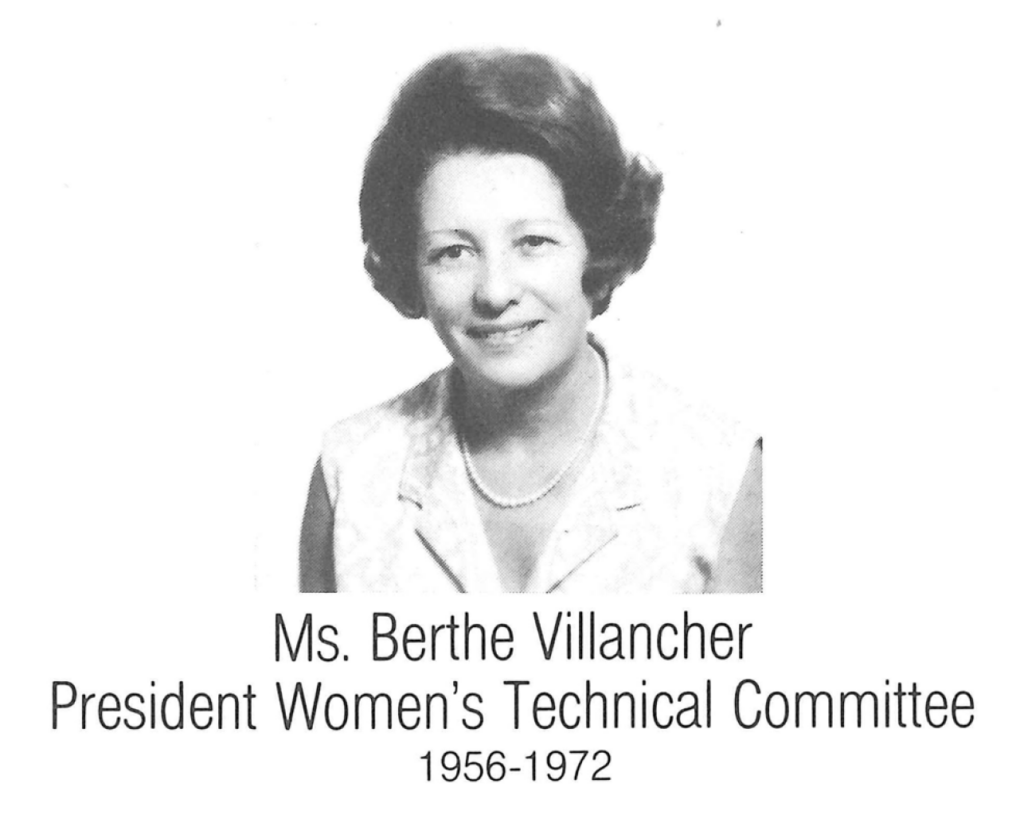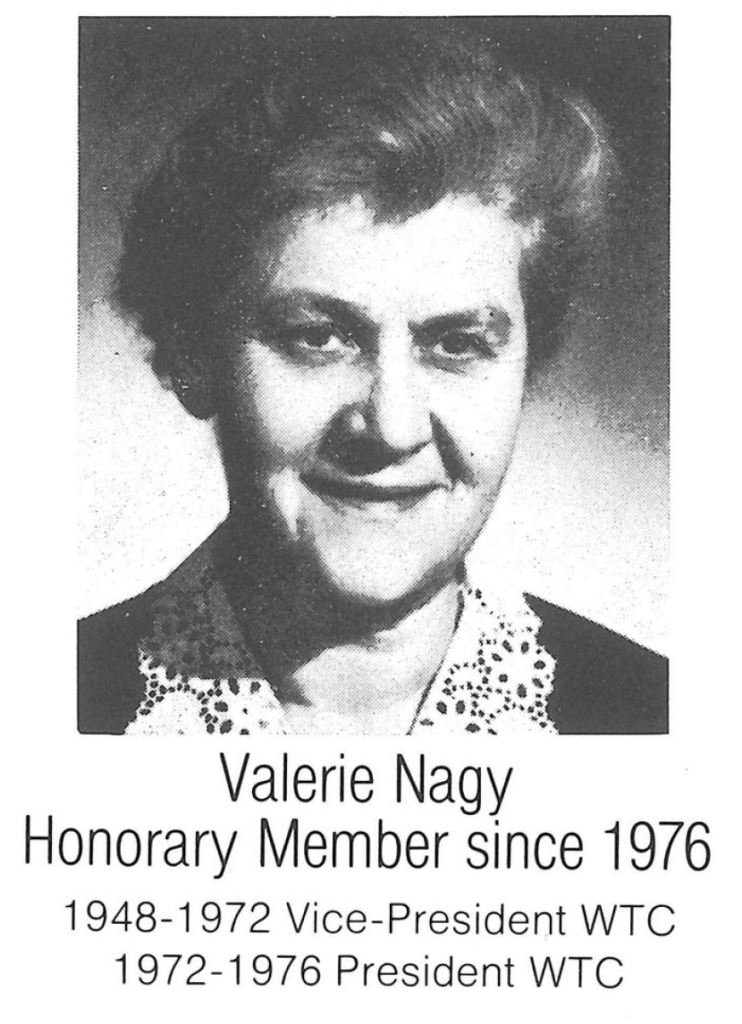In 1972, there was a change of the guard on the Women’s Technical Committee (WTC). Berthe Villancher, who had been the president of the WTC since 1956, finally stepped down. Valerie Nagy took her place.
Below, you can find Berthe Villancher’s thoughts on her final competition as the president of the Women’s Technical Committee, as well as what was top of mind for Valerie Nagy (Jenőné Nagy in Hungarian) when she was elected.
All in all, Villancher was pleased with how the 1972 Olympics turned out. Known for her interventions among the judges, she was happy that she did not have to intervene in as many judging controversies.

Villancher’s Final Thoughts
I am not saying goodbye to my friends
Mrs. Berthe Villancher — who was the leader of the Federation of International Gymnastics Technical Committee since the Olympics held in London in 1948* — said goodbye to this post in Munich: her friend and coworker Jenőné Nagy shall take over this post that comes with a lot of responsibility. The way the members and the president of the technical committee thinks sets the rate of development, and Mrs. Villancher, the expert who was leading this time for a quarter of a century, was a person who really did a lot to revolutionize women’s gymnastics.
[*Note: Villancher did not become president of the WTC in 1948. Marie Provazníková was in the role at the 1948 Olympics before she defected to the United States. Afterwards, fellow Czechoslovak Eleonora Buddeusová took over the role, but for political reasons, she found it difficult to leave the country to fulfill her duties, including attending the 1950 FIG Congress. Winifred Taylor of England was then president until her death in 1952, after which Liisa Orko of Finland was elected. After serving on the WTC for many years, Villancher of France was finally elected as president at the 35th Congress in 1956.]
After the finals of the individual competitions, they were celebrating the champions in the halls, we could hear the music the gymnasts listened to for three days. There were three of us in the room: Mrs. Villancher, Jenőné Nagy, and the journalist.
— After all these years what will it feel like to watch gymnastics from the stands?
— I am leaving feeling peaceful as the new leader is a person who has already done a lot for the development of gymnastics. I am certain that, with her leadership, there will be new successes in women’s gymnastics. One may leave their post, but not their friends. So, I am not saying goodbye. We, who have been working for women’s gymnastics for many years, are bound by an unbreakable bond.
— Under your leadership, women’s gymnastics has improved a lot. What was the thing that encouraged the development and was the key to this?
— It was a revolutionary decision to only have female coaches. This started the process that led to truly feminine gymnastics. The female gymnasts were just strong in Rome, but apart from a few true talents, there was nothing feminine in their exercises. And now beauty is what defines women’s gymnastics. The other significant step was that the exercises were performed with music. The emergence of music had an effect on how the exercises were composed and the design that was fit for the female body. Only the beam seems to be developing in the wrong way, it is dominated by acrobatics, which makes the beam a dangerous place. The development of women’s gymnastics still depends on how beauty and harmonic movements can be kept in it and further improved.
— How would you rate the work of the Olympic judges?
— These competitions were better than any Olympics previously held. It is a big joy for me that the Hungarians have a team that has a bright future ahead of them. The performance you gave here is proof that even in a sporting discipline this hard a few years are enough to achieve improvement. The Soviet and Eastern German girls there were a few incredible talents, and I find it an incredibly big achievement that Békési and Császár also got into the finals among them. Your experts seem to be moving in the right direction. I think that the judges were more balanced at the world championship as well, and when the audience showed their dislike, that was mostly caused by their lack of professionalism. This is evidenced by the fact that I, as the head judge, had to hardly intervene in the course of the competition.
[One example: Villancher intervened on floor exercise during the optionals portion of the competition, which increased Krisztina Medveckzy’s score by 0.15.]
Before I could move on to the next question the gymnasts came in to say goodbye, their eyes were a bit teary when they hugged Mrs. Villancher. Yet she only said goodbye to her post…
Képes Sport, Sept. 5, 1972
A barátoktól nem búcsúzom
Berthe Villancher asszony — aki az 1948-as londoni olimpia óta vezetője a Nemzetközi Torna Szövetség technikai bizottságának — Münchenben búcsúzott tisztségétől: munkatársa és barátnője, Nagy Jenőné veszi át a nem kis felelősséggel járó feladatot. A technikai bizottság tagjainak, elnökének felfogása mindig meghatározza a fejlődést, s Villancher asszony személyében negyedszázadon át olyan szakember állt a bizottság élén, akinek munkája valóban forradalmasította a női tornát.
Az egyéni verseny szerenkénti döntője után a folyosón még ünnepelték a bajnokokat, behallatszott a zene, amelyre három napon át meneteltek a tornásznők. A szobában hárman ültünk: Villancher asszony, Nagy Jenőné és az újságíró.
— Ennyi esztendő után milyen érzés lesz csak a lelátóról találkozni a tornával?
— Nyugodtan távozom, mert olyan szakember került a női bizottság élére, aki eddig is sokat tett a torna fejlődése érdekében. Biztos vagyok benne, hogy vezetésével a női torna újabb sikereket ér el. A tisztségektől megválhat az ember, de a barátoktól nem. Nem is búcsúzom. Minket néhányunkat, akik évtizedek óta dolgozunk a női tornáért, eltéphetetlen szálak fűznek össze.
— Az önök vezetésével nagyon sokat fejlődött a női torna. Mi volt, ami ösztönözte a fejlődést és miben látja az előrelépést?
— A forradalmi lépés, szerintem, amikor úgy döntöttünk, hogy a csapatok mellett csak női edzők lehetnek. Ez elindította azt a folyamatot, amelynek lényege a nőies torna felé való haladás. A női tornászok még Rómában is csak erősek voltak, s néhány kimagasló tehetség kivételével semmi nőies nem volt a gyakorlatukban. Most pedig a szépség a meghatározója a női tornának. A másik jelentős lépés a talajgyakorlatok zenére történő bemutatása volt. A zene
megjelenése a többi szeren is hatott a gyakorlatok összeállítására és a női alkatnak megfelelő mozgás kialakítására. Talán csak a gerenda fejlődik helytelen irányban, az akrobatikus elemek kerültek túlsúlyba s ez veszélyessé teszi a gerendán való mozgást. A női torna előrelépése változatlanul attól függ, menynyire lehet benne a szépséget, a harmonikus mozgást megtartani, s tovább javítani.
— Hogyan ítélte meg az olimpiai versenyeket, s a pontozók működését?
— Ezek a versenyek minden korábbi olimpiát túlszárnyaltak színvonalban. Számomra külön öröm, hogy a magyarok ismét nagyjövőjű csapattal rendelkeznek. Éppen a maguk itteni szereplése bizonyítja, hogy ilyen nehéz sportágban is elég néhány év a felzárkózáshoz. A szovjet lányok és az NDK versenyzőnői között néhány egészen kivételes tehetség mutatta be gyakorlatait, s nagy teljesítménynek tartom, hogy Békési és Császár bekerült közéjük a
szerenkénti döntőbe. Az önök szakemberei — úgy látszik — jó úton járnak. Állítom, hogy még az elmúlt világbajnokságnál is kiegyensúlyozottabb volt ezúttal a bíráskodás, s amikor a közönség nemtetszését fejezte ki, annak legtöbbször a hozzá nem értés volt az Indítója. Ezt bizonyítja az is, hogy nekem, mint főbírónak alig kellett a verseny menetébe beavatkoznom.
Mielőtt újabb kérdést tehettem volna fel, tornászok jöttek búcsúzni, egy kicsit fényes szemmel ölelték át Villancher asszony nyakát. Pedig ő csak a tisztségétől vált meg…

Nagy’s Election
Aunt Vali
Jenőné Nagy, the head coach of the [Hungarian] gymnasts is popular among the Hungarians and among foreigners as well. Everybody just calls her Aunt Vali. For some it is still hard to pronounce this Hungarian name, but others managed to learn it quite well. Her long work was crowned with a great deal of regard in Munich: she was chosen to be the president of the International Gymnastics Federation’s Women’s Technical Committee.
We met her after the meeting and well, Aunt Vali’s eyes were rather red. The ones who asked her if something happened to her, does she feel sick, got a quick and determined answer: “No! No, I was just crying the whole afternoon… Until now I worked for gymnastics, now I can represent it.”
But this statement does not have to be too seriously. In part because the president of the Technical Committee has very important tasks, and the other thing is that she did not forget about the Hungarian team either. This is proven by the conversation below as well.
— Sanyika — she asks this from Sándor Békési, one of the girls’ coaches —, did these girls gain weight?
This is how Aunt Vali broke through the ring of the well-wishers. And because Sándor Békési found it hard to answer, Aunt Vali did not leave anything to chance, she started to ‘give out orders’.
— Géza — this is Géza Benke, the team’s trainer —, you shall weigh the girls twice a day starting tomorrow!
The ‘order’ was determined and commanding. Poor girls were already looking at the portions of the rower boys… They should look at the boxers and the weightlifters instead!
Képes Sport, Aug. 28, 1972
Vali nénit
Nagy Jenőné, a tornászok vezető edzője igen népszerű, úgy a magyarok, mint a külföldiek között. Mindenki számára ő a „Vali néni”. Van ugyan, aki egy kicsit furcsán töri ezt a magyar nevet, de sokan vannak, akik már egészen jól megtanulták. Sok évi nemzetközi tevékenységét nagy megbecsülés koronázta Münchenben: a Nemzetközi Torna Szövetség Női Technikai Bizottságának elnökévé választották.
Az értekezlet után találkoztunk és bizony Vali néninek nagyon pirosak voltak a szemei. Akik aziránt érdeklődtek, hogy nem történt-e valami baj, csak nem betegedett meg, gyors és határozott választ kaptak: „Nem! Nem, csak egész délután bőgtem… Eddig a tornasportért dolgoztam, most reprezentálhatok.”
Azért ezt a kijelentését nem kell nagyon komolyan venni. Egyrészt, mert a Technikai Bizottság elnökének nagyon fontos tennivalói is vannak, másrészt, mert a magyar csapatról sem feledkezett meg. Ezt bizonyítja az alábbi kis beszélgetés is.
— Sanyika — ezt Békési Sándortól, a tornászlányok egyik edzőjétől kérdezi —, mondja, nem híztak meg ezek a lányok?
Vali néni ezekkel a szavakkal törte át a jókívánságokat kifejezők gyűrűjét. És mivel Békési Sándor bizony nagyon nehezen tudott választ adni a kérdésre, Vali néni nem is hagyta annyiban a dolgot, rögtön „intézkedett”.
— Géza bácsi — ez Benke Géza, a csapat gyúrója —, holnaptól kezdve naponta kétszer megméri a lányok súlyát!
A „parancs” határozott és ellentmondást nem tűrő volt. Pedig szegény lányok már eddig is vágyakozva nézték az evezős fiúk adagjait… Figyeljék inkább az ökölvívókét és a súlyemelőkét !
More on 1972